With competition finally coming from U.S.-built subcompacts. Volkswagen kept working to improve its bread-n-butter car, the Type 1 Beetle. In 1968, they introduced AutoStick, a manual transmission with an automatic clutch. And in 1971, they brought out the Super Beetle with more room up front for storage. The seller’s ’71 Bug is both these things, a Super Beetle with the AutoStick. A single-family car since new, the drivetrain has recently been rebuilt near Las Vegas, Nevada. It’s in great shape and available here on craigslist for $10,000. A salute to Pat L. for another nifty tip!
To help recapture market share, U.S. automakers got into the subcompact business in the 1970s. The Ford Pinto, Chevy Vega, and others targeted Volkswagen and imports from Japan. Not a company to be outdone, VW introduced the Super Beetle in 1971. It had a curved windshield, a longer hood, and remolded fenders. This enabled trunk space to increase by 80% thanks in part to the spare tire finally being stored flat. Mechanically, the new Beetles got McPherson struts in the suspension, disc brakes in the front, and – for the first time – optional air conditioning. The Super Beetle was priced at just $119 more than the standard Bug, which sounded like a great investment at the time.
Super Beetles used the existing 1,585-cc air-cooled VW engine. The seller’s car has the optional AutoStick, also known as the Volkswagen Automatic Stickshift. It was a 3-speed manual transmission paired with a vacuum-operated automatic clutch. By easily engaging a simple button/switch, the driver could alternate between normal manual shifting or letting AutoStick take care of the footwork for him/her. VW promoted the option from 1968 to 1976, dropping it presumably due to declining demand.
The seller’s Marina Blue Super Beetle looks quite nice. No issues can be seen with the body and the finish which may be original since the car has been garaged most of its life (only 47,000 miles on the odometer). The buyer shouldn’t have to worry about the car’s mechanical health as the drivetrain was refreshed 1,000 miles back. The original AM radio has stuck around with an aftermarket FM unit added to the mix. The front seats have been recently reupholstered, too. This looks like a really solid Bug!





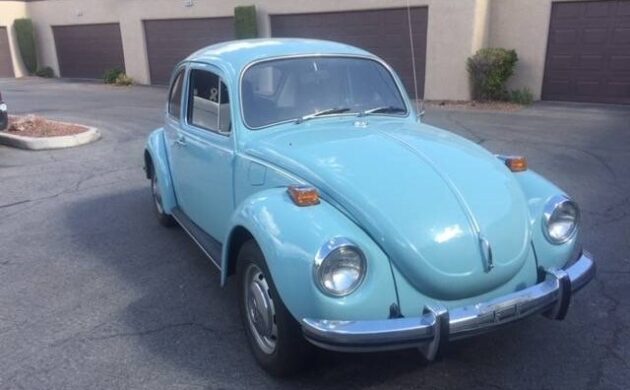
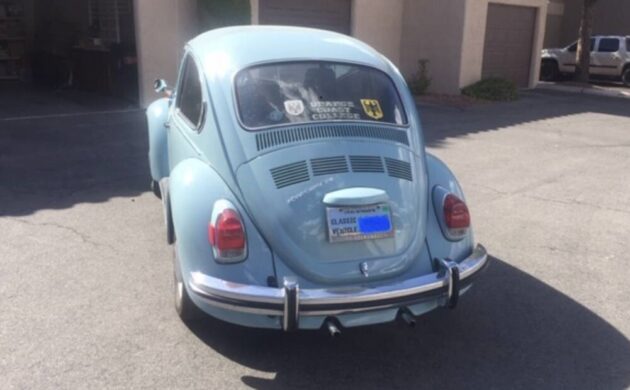
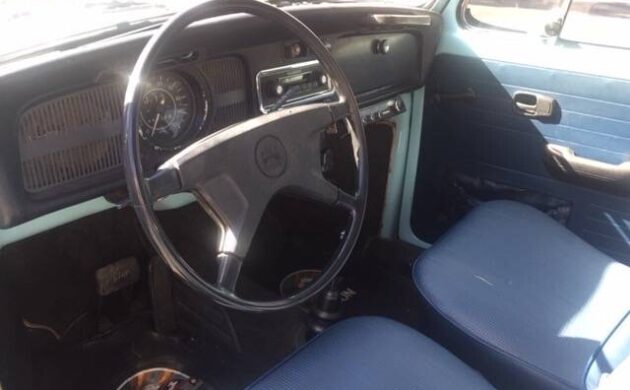

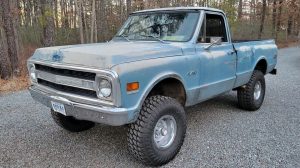
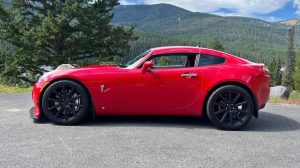




This looks like a steal at 10k .I’m not a vw guy but this car is cool.I like it!
I wish that I could afford this and it wasn’t on the other coast. I always wanted to try a auto stick bug
Actually the 71 and 72 Super Beetles retained the flat windshield. The curved windshield was introduced on the 73 model.
The price is lower because Super (Model 1301) Beetles are not as much in demand as the traditional Beetles. And there is reason for this: The front suspension, much better in geometry and using technology from Porsche, was not nearly as rugged or durable as the original front axle with its integral torsion-bar suspension.
The Super doesn’t have an evolutionary lineage to the early models, and – I would expect, although I haven’t owned one in 40 years – parts for strut rebuilding, bushings and drag-link hardware, all of which would wear, is probably scarce on the ground.
That said, the Super is far-better a road car; but what the MacPherson front suspension gives, the Auto-Stick taketh away. The torque converter on that is gonna soak up power, and that engine has none to spare.
Nor, do I expect, is there parts or supplies to spare. I have never driven one, but between the electric auto-disengaging clutch sensors and servos, and various automatic-transmission needs…no. Just, no.
If I got it at a price I couldn’t pass up, I’d probably want to retrofit it with a Beetle four-speed. But even THAT would be hard to find, especially since there were several major changes in transmission and shift linkage, over the course of the Beetle’s production run.
I hope this one finds an owner who can love it. I cannot; no matter how hard I want to.
I agree, the “SB” while the best Bug to come along, was just too late. People had their fill of VWs and there were so many better Asian cars, the Bug was doomed. I have been around a lot of VWs, ( even a Bug mechanic for 2 days), but never encountered an automatic. I think it was a poor decision on VWs part, a Bug with an automatic went agin everything we held dear. Fact is, many 1st learned how to drive a stick on an old VW, because they could take it. The Rabbit in ’75, while slow to start, was a more conventional car and changed everything.
I sold a ’72 autostick Beetle, same color, not quite as nice, as interior needed to be redone and paint was passable but that’s it. I sold it for $3900 two years ago. Was about right at that time, as autostick tranny cars just weren’t getting the looks. It’s a cool set up but you are correct on the parts availability and get a good Hanes manual so you know how to adjust it as needed. Parts were out there two years ago but were PRICEY then. I’m sure COVID hasn’t helped that. We used to call them autosuck trannies–cool concept but did rob a noticeable amount of power. Also, the tranny is solid, but clutch plate weak, if I remember, so you couldn’t do more than a 1651-1687cc rebuild bc it couldn’t handle more power than that. But for running errands and a basic mode of transport? Kinda cheap and fun.
The 3rd car I had in my early driving career was a 76 Honda Civic 1200 sedan with the Hondamatic “tranny”. Please tell me the bug didn’t suck as much as that Honda did with a wanna be auto trans?! That turd brown Civic did 0-55 back in the day in about 2 months. Was the semi-auto bug every bit as dreadful? Asking for a friend.
No the automatic stickshift didn’t suck. Nor did it make the car slower. And contrary to a previous post the torque converter did not rob power as it kept the engine in its power band. It was basically a conventional 4 speed VW transmission with no 1st gear. Normal driving was done in shift position 1 (the 4 speeds 3rd) and 2 (the 4 speeds 4th). A low gear (the 4 speeds 2nd) provided greater acceleration on steep hills or for quicker take offs. You could start off in any of the 3 forward gears but driving it in range 2 without shifting was where people complained of lack of power. It had a vacuum operated clutch activated by a microswitch in the gearshift. It had a torque converter to allow it to idle in gear as well as multiplying torque for better acceleration. Normal operation would have the driver shift once from 1 to 2 about 35-40 mph simply by moving the shifter and letting off the gas.
People don’t care to understand them nor care to and many of the complaints of jerky driving was caused by driving with your hand on the gear shift. Every bump in the road would move your hand and engage / disengage the clutch.
I had one in the new styled square back. I can vaguely remember making a “fast slipshift ” out of the transmission with a capacitor somehow . With it stroked and 88s it sure did fly…or seemed like it. The memory is deteriorating….
You are partially correct. The auto stick was a cool feature but it did add complexity and make the car slower. Remember even with a small clutch disc you were still driving on a fluid coupling so there was always a little slip. Most people don’t remember the Porsche 911 had the auto stick as well in the early 70’s. Not many of those exist but they still bring big money when they do come up for sale.
My 71 super Beetle is not slow with a 165hp. Subaru engine. It has surprised many in freeway on-ramps.
I had one years ago, mine had air, sunroof , and a upgraded sound system. The auto stick wasn’t that bad at all, never gave me any problems. Actually a fun car.
I guess all the reports that the Auto-Stick made a slow car slower were wrong! Sure.
No, not wrong. Anyone who’s lived through that era as a driver, knows that little cars of the time, with primitive smog controls, were dangerously slow. And automatic transmissions of the time (including the Automatic Stick Shift) had torque-converters WITHOUT lockup features. The torque-converter lockup was pioneered by Chrysler in the late 1970s, and quickly adopted across the board.
These cars didn’t have it…couldn’t.
A torque-converter is, reduced to essentials, a fluid coupling. The design of impellers in the converter, gives it effectively a variable pitch, but there is, and cannot help but be, power losses. It’s one reason that automatic transmissions get hotter when towing something – power input, viscosity friction, turned to heat.
Even with a manual (direct mechanical drive) transmission, the Beetle in those years was dangerously slow. The 0-60 time measured by Popular Science was…TWENTY-TWO SECONDS. They had a test on cars, 25-70 times – to simulate merging on freeways. The Beetle didn’t accelerate fast enough to complete that test in their available space.
We kids loved them, because it was a thumb in the eye of the Establishment, and because those cars were simple to fix and, if cared for, reliable. But they were slow and – just as with the American subcompacts – torque-converter transmissions made them more-so.
Today, a DCT (non-torque-converter) automatic transmission would be just the ticket for such a car. If we were allowed such a car. Alas…we are not.
“The torque-converter lockup was pioneered by Chrysler in the late 1970s, and quickly adopted across the board.”
The Packard Ultramatic transmission which debuted in 1949 had a lockup torque converter.
First I’d heard of it.
The “technology” magazines, Popular Science and Popular Mechanics, were all heralding Chrysler’s new-for-1979 locking/direct-drive torque converter, as an historic breakthrough that was to deliver about three extra miles a gallon on any given powertrain.
I just now read the Wikipedia entry for the “direct drive” feature on the Ultramatic. Okay…I got lied to…
Dang! And it was a good story, too. I last drove a girlfriends ’77 fuel injected,
4 speed Bug. It wasn’t fast, but it sure felt like it!
My first new car, a 71 Beetle, 4 speed. with slight mods. Wasn’t a muscle car, but it wasn’t underpowered, either. My girlfriend at the time, Liz (rest in peace) also liked it.
If you knew how to drive, the autostick bug was actually fun. The torque converter slip actually allowed the engine to find and deliver more torque off the line than the manual. You could double-clutch downshift an auto stick by releasing the gearshift in neutral, revving the engine to your next gear, then selecting your gear and releasing the gearshift. It looked a little silly, but the torque converter gave you clean smooth shifts. The sop to Americans was to advertize that you could drive around in 2 all day. Good grief no. These engines needed every gear.